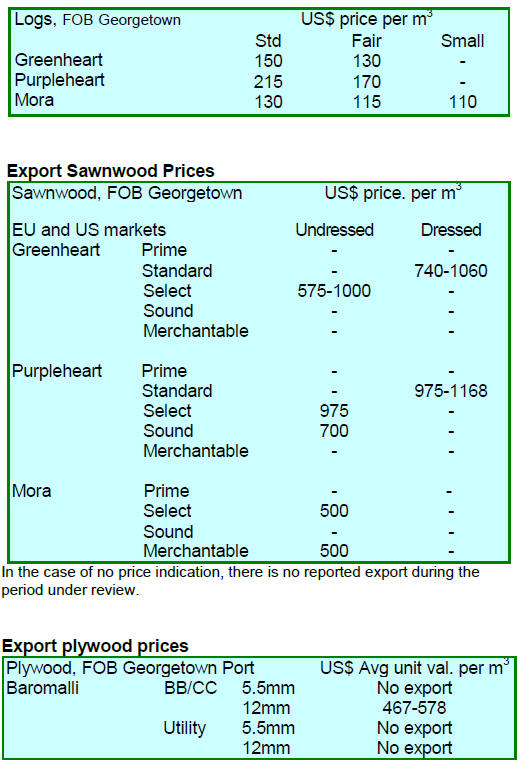2. GHANA
Illegal chainsaw milling to be eliminated
A forum on the Forest Law Enforcement Governance and
Trade (FLEGT) and VPA processes was held in Sefwi-
Wiawso in the Western Region to inform timber
producing communities of related forestry management
practices.
The forum, organised by the Working Group on Forest
Certification Ghana with sponsorship from the EU,
targeted those who have committed to Social
Responsibility Agreements (SRA), timber firms, the
Forestry Commission and District Assembly personnel.
Mrs. Doreen Asumang-Yeboah, Coordinator of the
National Forestry Forum-Ghana, said all participants are
responsible for the successful implementation of the
Ghana-European Union Voluntary Partnership Agreement
(VPA).
She informed participants that to ensure all legal
requirements under the Agreement were complied with it
will be necessary to eliminate illegal chain sawmilling
operations in the country.
Mrs. Asumang-Yeboah reminded participants that
timber
will only be considered legal when its source, timber
rights allocation, harvesting operations, transportation,
processing, trade and fiscal obligations meet national
regulations.
Industries continue to suffer from power crisis
The country‟s power crisis continues to have a major toll
on the economy. The effect of the crisis has compelled
major industries, including timber manufacturing
companies, to make tough decisions to avert the collapse
of their businesses.
Companies are now faced with huge bills for generating
power from mobile generators but point out this cannot be
sustained for long. With no available power from the
national grid industries are desperate for a solution and
many are experimenting with alternative power generation
systems such as solar energy.
Analysts point out that GDP growth will be affected if a
solution is not found quickly. According to a press release
from the Ghana Statistical Service (GSS), the protracted
energy crisis, lower commodity prices, rising inflation and
lower government expenditure took a major toll on the
country‟s economy in 2014.
Encouraging studies on indigenous timber species
Scientists have been urged to intensify research into
Ghana‟s indigenous tree species so effective regeneration
methods can be developed.
This call was made by Ms Barbara Serwaah Asamoah,
Deputy Minister of Lands and Natural Resources at the
opening of a one week international conference organised
by FORIG with support from the International Tropical
Timber Organization (ITTO) and the Th¨¹nen Institute of
Forest Genetics in Germany.
The conference was held to share findings from a
collaborative research study funded by ITTO to improve
the sustainability of indigenous mahogany in Ghana‟s
forest reserves.
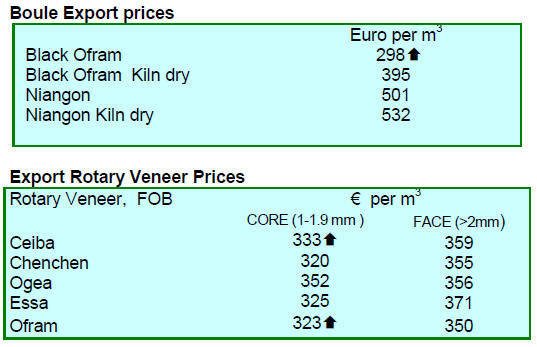
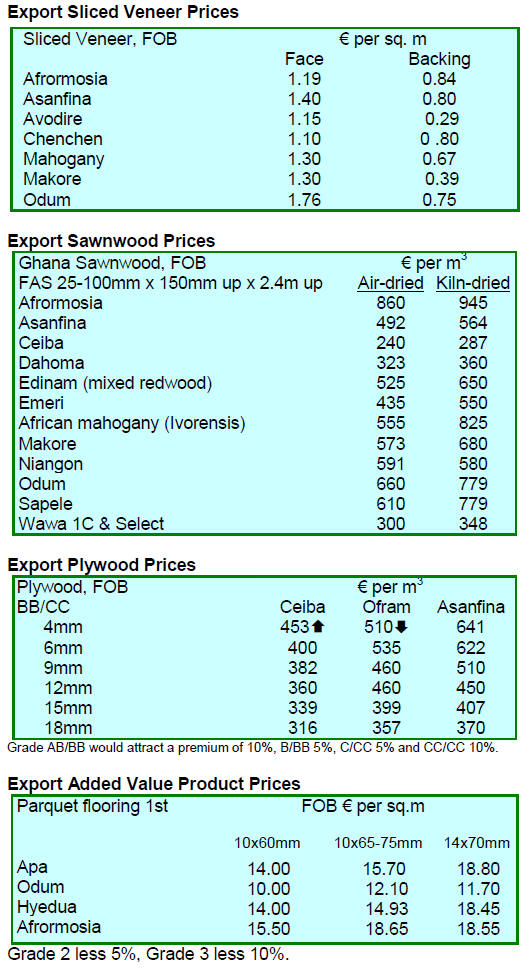
3. MALAYSIA
Year of the Goat off to a slow start
The Malaysian timber industry is slowly getting back to
business after the long Chinese New Year break, however
trading is reportedly slower than usual.
The ringgit:US dollar exchange rate has fallen to a twelve
month low as the dollar has strengthened on speculation
that the US Federal Reserve appears ready to raise interest
rates. The weaker ringgit has helped exports and Malaysia
registered a trade surplus of RM9.01 billion (approx. US$
2.44 billion) in January this year, a 42% increase
compared with the corresponding month last year. This is
the 207th consecutive monthly trade surplus.
Exports for January remained high at RM63.6 billion
(approx. US$17.2 billion) while imports fell by 5.3% to
RM54.59 billion (approx. US$14.8 billion) from a year
ago.
Growth in exports was recorded to major markets
such as
ASEAN (1.8%), European Union (3.7%), the US (18%)
and India (14.7 %). Exports also increased to Taiwan
P.o.C, Norway, Kenya and South Africa. On the other
hand, exports to Japan and China have been falling.
Designing with Malaysian sepetir
The Malaysian International Furniture Fair (MIFF) was
held in the first week of March in Kuala Lumpur. This
year MIFF featured over 508 exhibitors from 15 countries.
A new event ¡°Designing with Malaysian Hardwoods¡± took
centre stage in a first-time collaboration between the
Malaysian Timber Council and MIFF. Called ¡°Collection
Number One¡±, the design featured contemporary living
and bedroom sets made of Sepetir, a light golden brown
tropical hardwood.
In addition, a series of industry seminars highlighted
current trends and brought attendees face-to-face with
international industry experts. Among the speakers were
Italian industry consultant Enrico G. Cleva who shared his
views on new trends in furniture design while Roberta
Mutti and Franz Rivoira focused on products and lifestyle.
A two-member panel from the US Consumer Product
Safety Commission made a presentation on the
requirements for furniture sold in the US.
Universiti Putra Malaysia Professor Dr. Jegatheswaran
Ratnasingam, suggested Malaysian furniture exports may
not significantly increase from last year but the value of
the country‟s exports would increase due to the weakening
ringgit.
Strong demand for Sarawak logs in India
The general sentiment in Sarawak is that log prices are
expected to trend higher due to reduced availability.
The domestic press (Star newspaper), quoted Jaya Tiasa
Holdings senior manager Woung Lik Chiong as saying log
prices for the Indian market, the largest buyer of Sarawak
logs, had surged by between US$20 and US$25 per cu m
over a 12-month period.
India, which accounted for more than two-thirds of
Sarawak‟s export volume, was a stable market, said
Woung.
All out ¡®war¡¯ on illegal felling
Sarawak timber came under the spotlight last year when
authorities seized over 80,000 cu m of suspected illegal
logs. This was more than a six-fold increase in seizures
compared to 2013. In the first two months of this year,
some 16,000 cu.m illegally harvested logs had been
seized.
To underscore the seriousness of efforts to address illegal
logging Sarawak‟s Chief Minister cancelled or declined
renewals of about half of the 150 Occupation Tickets
(OTs) that allow holders to extract timber when preparing
land for plantation projects.
4. INDONESIA
Weaker rupiah good for exporters
The Indonesia rupiah recently fell sharply against the US
dollar on fears Indonesia‟s trade with China, its biggest
trading partner, will decline as China settles for a slower
and more structured growth model.
In mid-March the rupiah fell to 13,222 to the US dollar,
the weakest level since August 1998.
The weaker rupiah has an upside in that it supports exports
but with only the US economy showing firm signs of
recovery there are risks to Indonesia‟s export growth
potential.

The Indonesian Central Bank governor said the Bank
is
comfortable with the weaker rupiah as this, along with the
recent interest rate cut, will help drive the economy
forward.
Agus Martowardojo, the Central Bank Governor, has said
he expects further depreciation of the rupiah as interest
rates in the US are likely to rise sometime in the near
future. In February this year Bank Indonesia cut interest
rates for the first time in three years as inflationary
pressures eased and deflation returned in February.
SMEs struggle to compete in international markets
In a meeting with the Industry Minister Saleh Husin,
Ms.Soewarni, chairwoman of the Indonesian Sawmill and
Wood Working Association (ISWA), called on the
government to review the procedures required for small
and medium enterprises to secure SVLK conformity selfdeclarations
(DKP).
These declarations include four-digit commodity
identification codes for the products, type and timber
volume and sources of timber to ensure their legality.
Soewarni also called for the quick cancellation of the 10
percent value-added tax (PPN) on forest products imposed
since the middle of last year as this is undermining
competitiveness in the industry.
In related news the chairman of the Indonesian Furniture
and Handicraft Association has told government officials
that the timber legality verification system is having a
negative effect on the competitiveness of SMFEs which
found the approximate US$7,000 cost to secure
certification too high.
According to the association several furniture producers in
East Java have been forced to close factories as they can
no longer compete in international markets with producers
in Vietnam and China.
Cloud Seeding to bring fires under control
The Agency for Assessment and Application of
Technology (BPPT) plans to attempt cloud seeding in
Riau in an effort to control forest fires. The Minister for
Environment and Forestry, Siti Nurbaya, said the
government has declared a state of emergency in Riau and
has called for a coordinated effort to bring the fires under
control.
Reports suggest that from January the Siak Kecil
Biosphere Nature Reserve in Bukit Batu has been affected
as has Rupat Island. Data from the Fire Department show
that there were more than 100 forest fires in the first two
and a half months of the year.
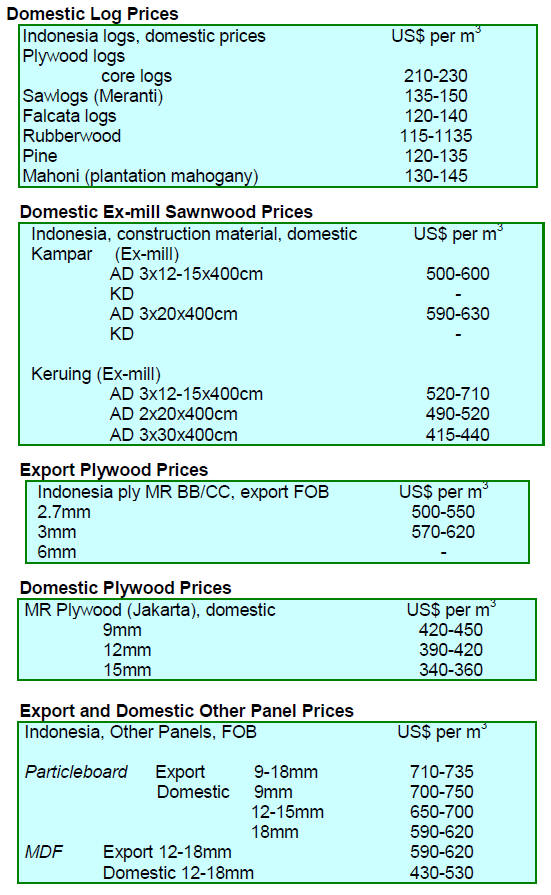
5. MYANMAR
The following timber was sold by tender
on 23 February
2015 and on 9 March 2015at the Yangon depot by the
Myanma Timber Enterprise (MTE). Average prices for
logs are expressed in hoppus tons.

Observers say that most of the teak logs recently
sold were
those which remained up-shipped when the log export ban
came into force last year and as such they were of poor
quality and this was reflected in the prices secured.
Teak harvest to fall below 100,000 tons
Analysts have expressed concern that MTE will be unable
to meet its harvest target of 60,000 hoppus tons of teak
logs for this fiscal year.
As the end of the fiscal year approaches it seems likely
this will be the first time in decades for the teak harvest to
be below 100,000 tons. The lower than expected teak log
harvest is likely to impact price trends in the coming
months.
Ex-site open tender prices
At the 9 March open tender sale at Chindwin
(Sagaing)/Bago and Pathein (only for the timber Taung
Thayet) the following prices were secured.
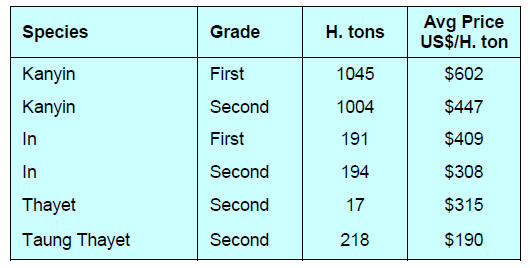
Most of the Kanyin logs were from the Upper
Chindwin
River area in Homalin and Mawlike (Sagaing Division),
North West Myanmar.
Only about 600 tons were from the Sittang River Rafting
Agency and Bago North Area. Kanyin is Dipterocarpus
spp; and In is Dipterocarus tuberculatus. Kanyin is also
called Myanmar Gurjan. Thayet or Taw Thayet is
Mangifera caloneura. Taung Thayet is Swintonia
floribunda.
Kanyin logs are purchased for peeling veneer and In
logs
are for cutting into sawn timber. Gurjan is sought for
making container flooring.
Foreign investment rules relaxed
The domestic newspaper, Eleven Media, has reported that,
according to Directorate of Investment and Company
Administration (DICA), foreign investment in Myanmar is
expected to total just under US$7 billion for the current
fiscal year.
The Myanmar government is trying to attract investment
into its most labour-intensive sectors. Foreign investors
are now allowed to rent either privately owned or stateowned
land, they are also permitted to operate without
local partners and the process of fund repatriation has been
simplified.
6.
INDIA
CREDAI ¨C nothing in budget for real
estate sector
The 2015-16 Indian budgets has been applauded as it
attempts to address stagnated growth, the bloated public
sector and weak private investment. The main thrust will
be investment in infrastructure, stimulating capital
investment, devolution of finances to the States and a
range of initiatives for Indian‟s poor.
The business community has generally welcomed the
budget saying an immediate investment in improving
infrastructure will boost the economy in the short term and
will have a lasting impact on long term growth prospects.
A summary of the main points of the budget can be found
at:
http://indiabudget.nic.in/ub2015-16/bag/bag11.pdf
Despite overall positive view of the budget the real estate
sector has expressed disappointment. In the March
newsletter from the Confederation of Real Estate
Developers‟ Associations of India (CREDAI) an article
asks ¡°What Does the Union Budget 2015-16 mean for the
Real Estate Sector¡±.
The article goes on to say ¡°There is nothing in the budget
to give impetus to the sector although the sector provides
much needed employment. Yet, the only provisions in the
budget for the sector are pass through tax for investments
in the Real Estate Investment Trusts (REITs).
To top it all, contrary to our demands the service tax on
affordable housing has been increased from 12.36 per cent
to 14 per cent, adding to the cost of houses.¡±
CREDAI Chairman Lalit Jain, says the increase in service
tax could lead to an increase in home prices by as much as
half a percent and ¡°the only comfort to be derived from
real estate drawing a blank is that there are no provisions
adverse to the real estate sector¡±.
For more see:
http://credai.org/sites/default/files/Issue-24-Real-Estate-at-
Glance-02-03-2015.pdf
Welcome decline in inflation
The Office of the Economic Adviser (OEA) to the Indian
government provides trends in the Wholesale Price Index
(WPI).
The official Wholesale Price Index for „All Commodities‟
(Base: 2004-05 = 100) for January fell almost 1% to 178.3
from 179.8 for the previous month. The annual rate of
inflation, based on the monthly WPI, fell 0.4% in January
2015.
For more see:
http://eaindustry.nic.in/cmonthly.pdf
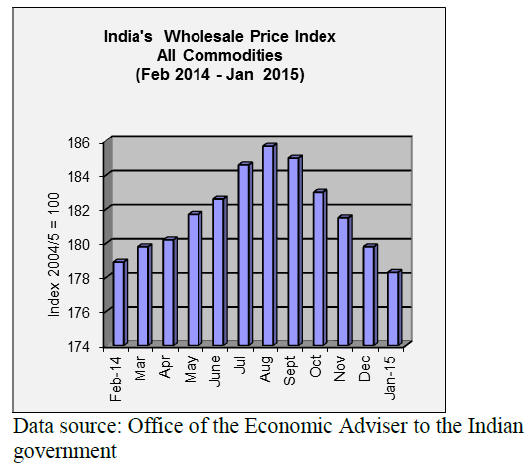
Timber and plywood wholesale price indices
The OEA also reports Wholesale Price Indices for a
variety of wood products. The Wholesale Price Indices for
Wood products and Plywood are shown below.
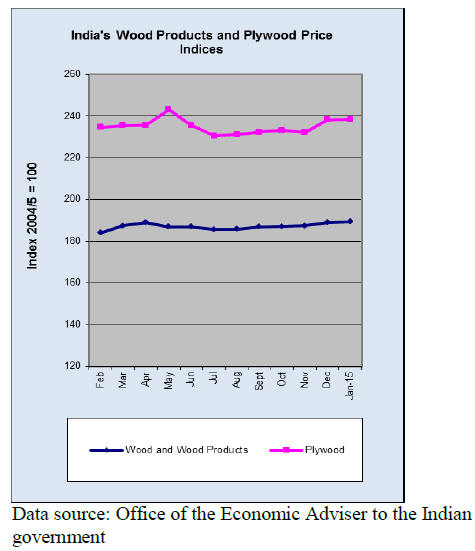
The January price index for wood and wood products
rose
slightly part of the rise may be explained by the increase in
Sarawak log prices.
Similarly the price index for plywood rose
reflecting the
price increases achieved by plywood manufacturers.
See:
http://eaindustry.nic.in/display_data.asp
E-Auction of teak in Western India
The disagreement over the e-auction means of sale is still
unresolved. A large volume of logs are ready for sale so it
is in the interest of the Forest Department and buyers to
find an amicable solution so sales can proceed.
Current C&F prices for plantation teak
Traders report a steady flow of plantation teak.
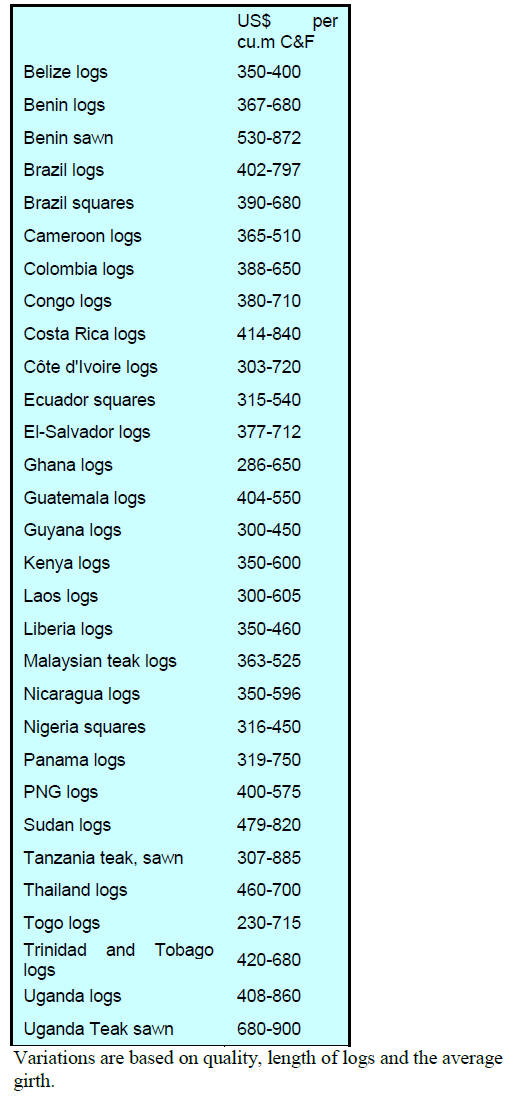
In addition to the plantation teak arrivals,
natural forest
teak logs from Vietnam continue to arrive and prices are
unchanged at US$1349 per cubic metre.
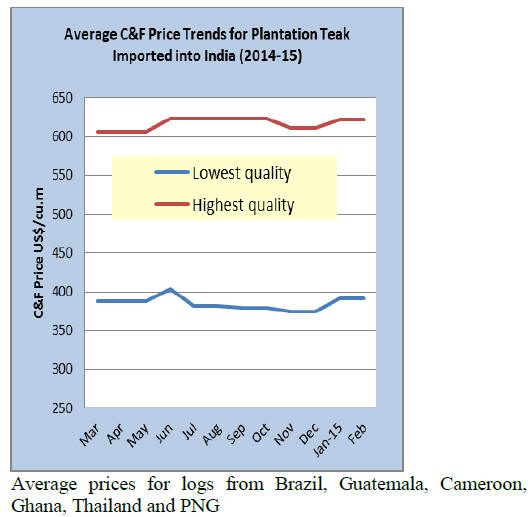
Increased imports of logs from Sarawak
Since Myanmar implemented the log export ban Indian
traders have increased purchases from other sources.
Currently, Sarawak is the main supplier of non-teak
hardwoods to India. India‟s year on year log imports from
Sarawak increased by just over 13 % between January and
September last year.
Prices for domestically milled sawnwood from
imported logs
Current exmill prices for air dried sawnwood are shown
below. As reported previously, prices have not changed
over the past two weeks.
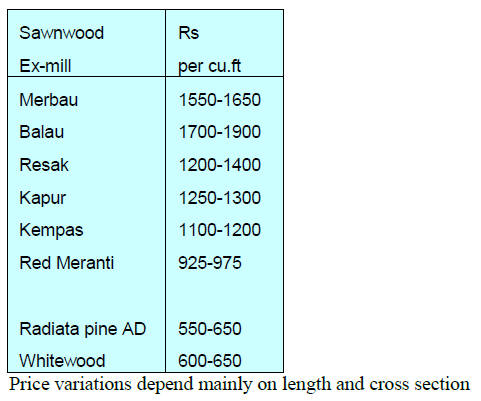
Prices for imported teak sawnwood
The volumes of sawn teak imports from Myanmar are
rising but analysts comment that the quality of the
sawnwood being shipped should be improved to meet the
demands of the market.
The rise in arrivals of sawn teak from Myanmar is
reflected in a slight easing of teak sawnwood prices.
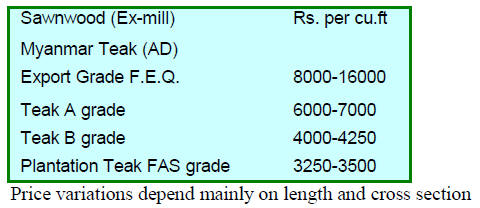
Imported 12% KD sawnwood prices
The prices below are per cu.ft ex-warehouse.
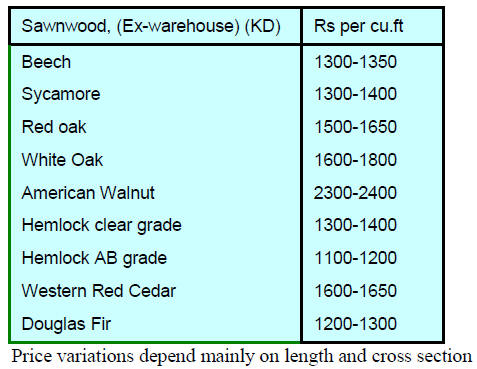
Acceptance of poplar a lifeline to plywood
industry
When Myanmar stopped exporting gurjan logs Indian
plywood manufacturers began experimenting with other
species and some positive results are emerging. Despite
the preference of end-users for plywood with red face
veneers, poplar logs are emerging as a source of veneer for
plywood manufacture.
In India poplar plywood is rapidly gaining acceptance
which has eased the problem of obtaining veneers faced by
plywood manufacturers and is also benefitting end-users
as poplar plywood is cheaper than panels previously made
with gurjan.
However, plywood manufacturers have been forced to
raise prices mainly due to rising wage bills which is
pushing up production costs. It is fortunate that the market
is accepting poplar faced plywood otherwise the price
increases would have been higher.


Bamboo development in NE India
India has one of the largest reserves of bamboo in the
world and 70% of this natural resource is found in the
North Eastern part of the country. The North East Centre
for Technology and Research is promoting bamboo for
various uses such as laminated beams, door and window
frames, chairs, and sofa sets, coffee tables as also flooring.
North Eastern states of India are priority areas for
development. Reforestation activities are continuing and
processing bamboo is being encouraged.
7.
BRAZIL
Mato Grosso do Sul calls for review of
land acquisition
policy
During the recent State Forestry Congress the governor of
Mato Grosso do Sul called on the Attorney-General to
examine the restriction on the sale of land to foreigners.
Under the existing law, land acquisition by foreigners and
Brazilian companies controlled by foreigners is restricted
and this is limiting investment inflows.
Most business groups wishing to invest in forestry can
only do so through participation in Brazilian companies. A
change policy is likely to result in greater investments
which will benefit the state economy according to the
governor .
It has been reported that in Mato Grosso do Sul there are
some 9 million hectares of degraded land suitable for
forest plantations.
The area of planted forests in Mato Grosso do Sul has
expanded from around 90,000 hectares in 2003 to 800,000
today. The aim was to achieve 1 million hectares by 2020
but this target will be reached ahead of plan.
Prospects for the furniture sector
According to the Brazilian Market Intelligence Institute
(IEMI), prospects for the furniture sector in 2015 are
bright despite the disappointments of 2014.
IEMI estimates a 1.4% growth in revenues for
manufactures and a 10% growth in revenue to furniture
retailers.
2014 was the first year for a decline in furniture output
since IEMI started to compile data on the sector and the
main reasons behind the fall were weak domestic demand
and a tightening of domestic availability of credit.
IEMI was created to attend to the growing demand of
industries for statistics related to the market for different
sectors.
Initiative in support of exporters
The Ministry of Development, Industry and Foreign Trade
(MDIC) and APEX Brazil, (the Brazilian Agency for
Export and Investment Promotion) met with
representatives of the Brazilian Furniture Industry
Association (ABIMÓVEL) as well as representatives from
around 80 other national Industry associations. The
purpose of the meeting was to outline the government‟s
plan to support exporters.
The aim is to revive Brazil‟s foreign trade especially
manufactured goods exports through partnerships between
private and public agencies. The focus will be on trade
promotion, market access, exports financing, trade
facilitation, taxation and transparency and private sector
participation.
ABIMÓVEL presented data on the furniture industry
during the meeting and identified where action is required
such as:
 a review of the Export
Financing Program
a review of the Export
Financing Program
(PROEX);
 elimination of exports taxes,
particularly the
elimination of exports taxes,
particularly the
tax on circulation of goods and services
(ICMS);
 guarantees to attract private capital
for longterm
guarantees to attract private capital
for longterm
financing;
 revision of rules that restrict
back-to-back
revision of rules that restrict
back-to-back
operations;
 trade agreements and
negotiations with
trade agreements and
negotiations with
Colombia, Peru, Chile and an effective
agenda for MERCOSUR;
 addressing the negative impact from the
end
addressing the negative impact from the
end
of General System of Preferences (SGP) and
the importance of establishing an agenda of
negotiations with the United States;
 reviewing double taxation agreements;
reviewing double taxation agreements;
assessment of logistics costs that undermine
the competitiveness of exporters;
 the need to establish a foreign trade
policy.
the need to establish a foreign trade
policy.
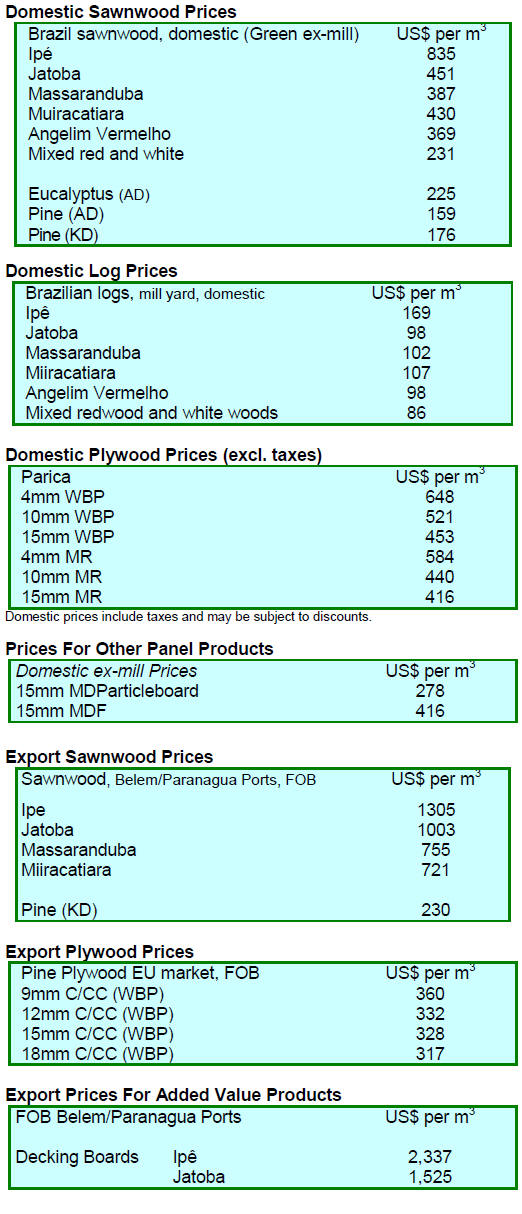
8. PERU
GPS locators for Amazon basin vessels
Authorities in Peru are considering requiring all boats
plying the Amazon basin to install GPS devices so they
can be tracked. This is part of the plan by the Commission
for the Fight Against Illegal Logging aimed at stopping
transport of illegally harvested logs and sawnwood
produced from such logs.
This proposal is being discussed with the National Forest
and Wildlife Service to devise new regulations requiring
the installation of GPS locators on river craft.
Currently, GPS locators are installed on Peru's
fishing
boats to monitor their movements and track if they enter
areas in the Pacific Ocean where fishing is banned.
Improved exports of non-traditional products
Peru‟s exports (excluding minerals) grew 4% in 2014
compared 2013 and earned US$10.5 bil. according to the
Center for Foreign Trade in the Lima Chamber of
Commerce.
The Center noted that ¡°over the past five years (2010-14)
the average growth in exports of non-traditional products
was 10% and that the performance in 2014 was a
disappointmen¡±t.
Peru has trade agreements with many countries or blocks
but just seven of these accounted for over 80% of all
export shipments of value-added products in 2014.
The main markets were the USA (US$2.8 billion); the
European Union(US$2.3 billion) and the Andean
Community of Nations.
Exports to Chile, Mercosur countries and China totalled
US$2.2 billion or around 20% of total exports. Imports by
the USA and EU increased in 2014 but it was imports by
Colombia and Bolivia that recorded the highest rate of
expansion.
Peru - levels of entrepreneurship down in 2014
The Institute of Economics and Business Development,
within the Lima Chamber of Commerce has reported that
according to the Global Entrepreneurship Monitor (GEM)
Peru is the fifth largest economy in Latin America and in
2014 achieved a high level of entrepreneurship.
In the GEM 2014 report Peru‟s entrepreneurial activity
rating at 28.8% was higher than that of Bolivia (27.4%)
and Chile (26.6%) but below that of Ecuador (32.6%), the
leader in the region.
However, compared to previous years labour productivity
in Peru declined in six of the eight sectors used to
determine the overall productivity rating. The most
dramatic declines were recorded in fishing (-16.6%),
electricity, gas and water (-15.4%) and construction (-
8.2%), while positive results were obtained in trade (2% )
and services (4.9%), says the Chamber.
See:
http://www.camaralima.org.pe/principal/noticias/3

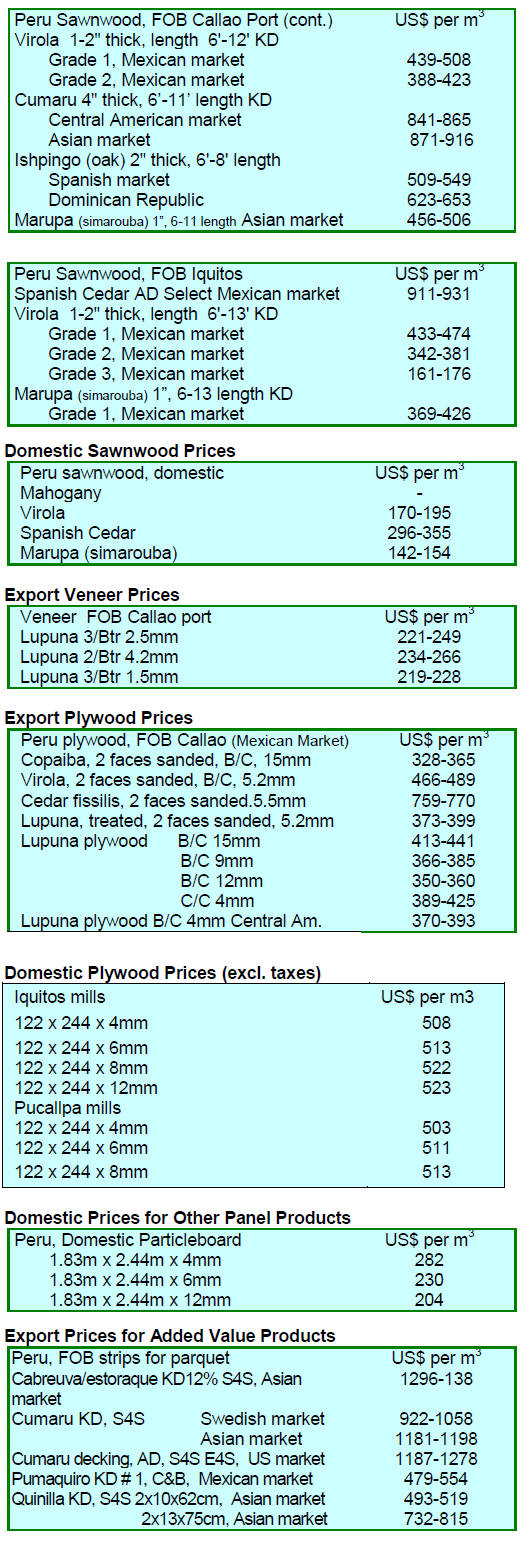
9.
GUYANA
Challenges in shipping from Georgetown
Port
The main port in Guyana is Port Georgetown situated on
the north coast of Guyana along the East Bank of the
Demerara River. The port is run by a Maritime
Administration Department operating under the Maritime
Act.
Draft limitations have always been a problem in
Georgetown along with the 3-4 metre tide range. The
access channel to the port is always under threat from
heavy silting and this is a challenge for the authorities as
regular dredging is necessary.
Export prices
There were exports of greenheart, purpleheart and mora
logs in the period reported.
